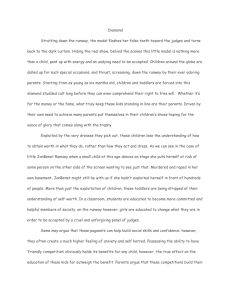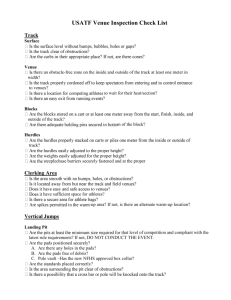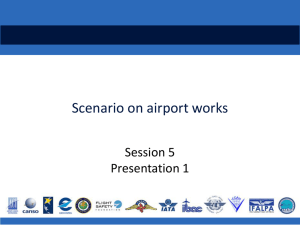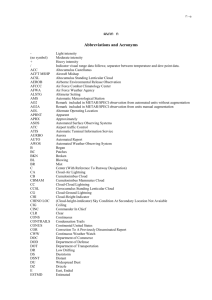ASW Runway Safety Summit 04-2008
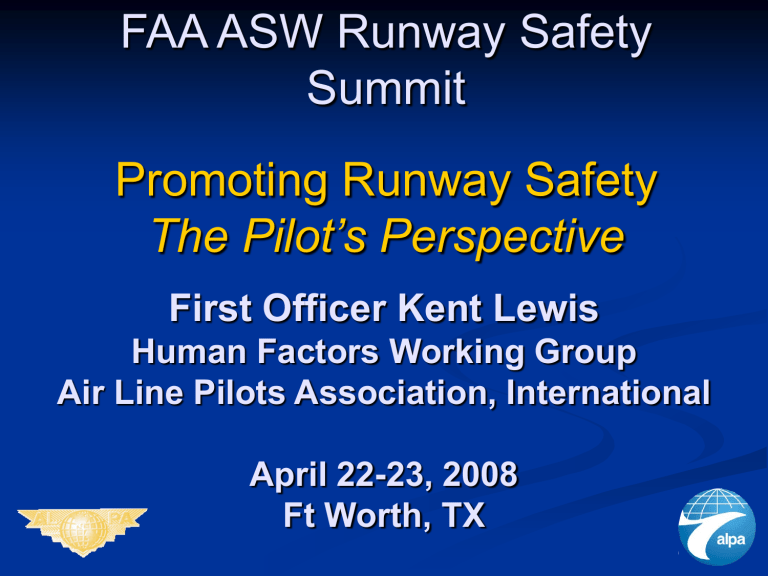
FAA ASW Runway Safety
Summit
Promoting Runway Safety
The Pilot’s Perspective
First Officer Kent Lewis
Human Factors Working Group
Air Line Pilots Association, International
April 22-23, 2008
Ft Worth, TX
FAA ASW
Runway Safety Summit
Special thanks to:
ALPA Engineering & Air Safety
Pierre Huggins
Terry McVenes
Shawn Pruchnicki
Who Is ALPA?
Represent 54,000 pilots at 41 Air Lines in
North America
IFALPA represents over 104,000 pilots at
90 member Associations
Safety makes up a significant percentage of the operating budget
Why? “Schedule With Safety” been our motto for 76 years
Looking for Ways to Better
Manage Risks Before They
Become Accidents
ALPA Safety Committee
Project Overview
178 Funded Projects Across 13
Technical Groups
Plus
9 Accident Investigations
Our Roadmap
ALPA Safety Committee
Priorities
Implementation of CNS
Systems
Accident Investigation
& Prevention
Aircraft Design
Pilot Fatigue
Pilot Training & Licensing
Air Traffic Capacity
Initiatives
Runway Safety
Safety Management
Systems
Cargo Safety &
Dangerous Goods
Environment & Energy
Strategies
30 years ago…
The potential severity of runway incursions was fully realized
We also faced great risk of:
CFIT accidents
Windshear accidents
Mid-air collisions
Threat: Controlled Flight Into Terrain
Threat: Low Level Windshear
Threat: Mid Air Collision
Evaluating the Risk of
Runway Incursions
Runway Incursion Likelihood
Two commuter aircraft, Quincy, IL, November 11, 1996.
Runway Incursion Incidents in the US
FAA and ICAO Data, 2003 - 2007
1000
800
600
400
200
0
2003 2004 2005 2006 2007
FAA
ICAO
Runway Incursion Severity
Runway Incursion, B737 & Metro III Collision at LAX
February 1, 1991
Fatal Runway Incursion Accidents in the US, 1990 - 2007
1990 Atlanta, GA: B727 / Beech A100
1990 Detroit, MI: DC9 / B727
1991 Los Angeles, CA: B737 / SW4
1994 St. Louis, MO: DC9 / C441
1996 Quincy, IL: Beech 1900 / Beech A90
2000 Sarasota, FL: C172 / C152
2006 Lexington, KY: CRJ 100
112 Fatalities
Runway Incursion Incidents in the US
May – September 2007
San Francisco: E-170 / E120….....…..35 feet (est)
Teterboro: P180 / SR22 ...…50 feet (max braking)
Fort Lauderdale: A320 / B757….…...…..…230 feet
New York: CRJ100 / B737….…...….……..650 feet
Teterboro: LJ45 / CL60…………....…...…1200 feet
Los Angeles: B737 / A320 ……….………….37 feet
Washington: LR35……………...... Closed runway
792 Crew and Passengers
Conclusion: Runway Incursion
Risk is Unacceptable
Runway Incursion
Mitigations
We cannot change the potential severity of an incursion
We can reduce the likelihood of an incursion through layers of mitigations
CAST recommendations made in 2002 to reduce frequency of incursions
Most not yet fully implemented
Highly Effective Mitigations:
Aircraft Moving Map
Add traffic to display
Runway occupancy advisories
Graphical/text of taxi and clearance limits
ASDE-X
All great “high tech” solutions
Don’t Judge a Book…
“Modern” Airliner Flight Deck with Steam Gauges
… By It’s Cover!
Flight Deck of
Small General Aviation Aircraft
Intelligent Design
Many airports have exceeded their design capacity and were engineered for a different generation of aircraft.
Hotspots
The challenge is to design
Airports that
Do Not
Require
Hotspots!
End-around Taxiway
A better design at DTW
End
Around
Taxiway
Atlanta
Low Tech Solutions
Enhanced Runway Markings
Runway Status Lights
Enhanced Airport Lighting
Program
PAINT and LIGHTS
Can You See Me Now?
Before After
Graphics not to scale
Contrast Contrast Contrast
Taxiway Centerline
Enhancement
Enhanced Complex
Intersection
NOTAMS
Has the time come to start over?
Technology exists to deliver a better product
Are they Intuitive?
Are they as effective at communicating critical information as we would like?
A “real challenge” for future growth
Training, SOPs, & Education
Screen Capture from ALPA Web Site www.alpa.org
Investigation
Beyond Probable Cause…”Probability” of
Cause, maybe?
We know Who did What.
Why did system not support expert operators?
System must be resilient to random errors made by expert operators.
SHEL Model
We are the Liveware in the middle, surrounded by a system or “SHEL”
S = Software
Transfer of information between the human and supporting systems
Philosophy
Policy
Procedures
Checklists
Publications
Regulatory requirements
Information systems
H = Hardware
Physical and mental interactions between the person and machine or equipment
Systems management
Autoflight, Powerplants, Air conditioning,
Pressurization, Flight Controls, aircraft configuration, Com/Nav/Ident radio(s)
Information displays
Flight, nav, weather, traffic, performance
Flight deck design and limitations
Restricted vision
Synthetic vision
E = Environment
Internal Factors
Personal comfort
Temperature
Glare
Noise
External Factors
Day/night
Visibility
Weather
Lights
Signs
Markings
Runway condition
L = Liveware
The nature of humans (physiology) and interactions between humans (psychology).
Voice communications
Phraseology
Speech content/rate
Language barriers
Read & hear back
Crew briefings
Crew interactions
Labor relations
Non-verbal cues
Physiological
General health
Nutrition
Visual detection and acuity
Stress
Fatigue level
Arousal level
Psychological
Mental capabilities
Perceptions
Information processing
Attention span
Workload
Motivation
Time compressed decision making
Knowledge (including training)
Attitude
Personality
Situational
Assessment
Concurrent task management
Prospective memory
SHEL Model
The interface or edge between each component of the system is not clean and smooth, but rather jagged and fuzzy. This is another area where hazard and error exist.
Safety Improvements Wanted
Runway Incursions
Require all runways crossings be authorized only by a specific clearance. A-00-67
Require runway crossing clearances be issued only after the previous runway has been crossed. A-00-68
ALPA White Paper on
Runway Incursions
WWW.ALPA.ORG
Priority Action Items
AMM with own-ship display
RWSL
THL
Enhanced airport markings
Perimeter taxiways
Improve SOP for aircraft ground ops
Improve ATC ground movement training
Provide ATC with better technology
Improve automation and visual aids at airports
Safety Enhancement
Collaborations
AC 120-74A SOP for Ground Ops
On-Line Pilot Education – 12,000 course completions
FAA/ALPA DVD – “Was That for Us?”
AC 150/5340-1J Painting and Markings
RIIEP
WWW.ALPA.ORG
ALPA Runway Safety Website
ALPA Hold Short for Runway Safety http://www.alpa.org
Safety/Security tab
Another Runway Safety Issue
RUNWAY EXCURSIONS
Air France, August 2005
Toronto Runway 24L
Runway Safety Areas
Non-compliance
Schedule
Declared Distances
When is a runway not a runway
Need information more accessible to pilots
All charts should show useable lengths
No exceptions! Not 200, not 400, not 600!
Runway Safety Areas need to be at least
(!!!) 1,000’long!!!
EMAS
EMAS – One option
ALPA Position on EMAS
“Air carrier airports should upgrade all runway safety areas. Where upgrades that meet minimum standards of AC
150/5300-13 or ICAO ANNEX 14 Section
3.4 are not feasible, Engineered Materials
Arresting Systems (EMAS) should be installed.”
Runway Safety –
A Puzzling Issue…
Which Will Be Solved
When We Work Together
Moving
Map
Display
Runway
Status
Lights
Surface
Movement Radar
Perimeter Taxiways
Training &
Communications Visual Aids
A Call For Action
We have the knowledge and the means to eradicate the incursion problem
Do we have the political will, and will we expend the necessary resources to do so?
THANK YOU for your commitment to the continuous improvement of aviation safety.
Together we are making a difference

